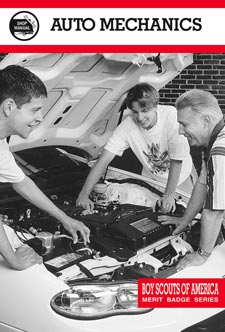NOTE: Access to an automobile or truck (with owners manual) is needed
to meet some of the requirements for this merit badge.
- Discuss with your counselor the safety equipment, tools, and clothing used while checking or repairing a motor vehicle. Use this equipment, tools, and/or clothing (when needed or called for) in meeting the requirements for this merit badge.
- Explain how an internal combustion engine operates and the differences between gasoline and diesel engines.
- Demonstrate your knowledge of general maintenance. Do the following:
- Demonstrate how to check the fluid level of the following:
- Brake Fluid
- Engine Oil
- Coolant
- Power steering fluid
- Windshield washer fluid
- Transmission fluid (automatic and standard)
- Check battery fluid, if possible, and the condition of battery terminals.
- Show the location of fuse boxes and the size of fuses, and demonstrate the proper replacement of burned-out fuses.
- Review the maintenance chart in the owner's manual. Explain the requirements and time limits.
-
- Choose a car cleaner and wax product for the vehicle. Explain clear-coat paint and the precautions necessary for care. Clean and wax the vehicle, both inside and out.
- Use a vinyl and rubber protectant (on vinyl tops, rubber door seals, sidewalls, etc.) and explain the importance of this protectant.
- Demonstrate how to check the condition and tension of belts and hoses.
- Demonstrate the following:
- Check the lighting in the vehicle, including instrument, warning, and exterior bulbs.
- Check headlight alignment
- Demonstrate how to check the vehicle exhaust system.
- Demonstrate how to check the fluid level of the following:
- Demonstrate your knowledge of the following:
-
- Explain the difference between tire and vehicle manufacturer's information specifications and demonstrate where to find these specifications.
- Demonstrate how to check pressure and properly inflate a tire.
- Using the manufacturer's jack supplied with the vehicle:
- Demonstrate how to engage the jack correctly on the vehicle.
- Demonstrate how to change a tire correctly .
-
- Explain the difference between bias-belted tires and radial-belted tires.
- Diagram and explain in writing how to rotate bias-belted and radial-belted tires.
- Using the manufacturer's guidelines, rotate the tires on the vehicle.
-
- Explain the camber, caster, and toe-in adjustments on wheel alignment.
- Explain why wheel alignment is important to the life of a tire.
- Explain the purpose of the lateral-wear bar indicator.
- Explain how to dispose of old tires properly.
-
- Demonstrate your knowledge of engine lubrication. Do the following:
- Explain the purpose of motor oil.
- Explain where to find the recommended type and amount of oil to be used in the vehicle engine.
- Explain the difference in viscosity (10W/30 versus SAE 30).
- Perform an oil change and oil filter change on a vehicle.
- Explain how to dispose of the used oil and filter properly.
- Cooling system Do the following:
- Explain the need for coolant in the cooling system.
- Flush and change the engine coolant in the vehicle according to the manufacturer's instructions.
- Explain how to dispose of used coolant properly.
- Demonstrate your knowledge of a fuel system. Do the following:
- Explain how the air and fuel system work together.
- Explain how a carburetor works and how a fuel- injection system works.
- Explain how an on-board computer works with the fuel injection system. Show where the computer is located.
- Explain why it is necessary to have an air filter and a fuel filter. Locate them and change them according to the manufacturer's recommendations.
- Explain what fuel additives are. for both the carburetor and the fuel injection systems.
- Demonstrate your knowledge of ignition and electrical systems. Do the following:
- Diagram and explain the parts of the electrical system.
- Explain the cylinder engine sequence.
- Explain the spark plug gap and if practical, change the spark plug. (Use an engine with spark plugs that can be reached without tilting the engine.)
- Demonstrate how to connect jumper cables on your battery properly. Explain how to jump-start a vehicle.
- Explain the difference between electronic and point ignition systems.
- Demonstrate your knowledge of a drive train. Do the following:
- Diagram the drive train and explain the different parts.
- Explain the difference between automatic and standard transmissions.
- Explain the types of automatic transmission fluid.
- Explain the types of lubricants used in a standard transmission and in the differential.
- Explain the difference between front-wheel, rear- wheel, and four-wheel drive.
- Explain the gear ratio of the differential.
- Demonstrate your knowledge of a brake system. Do the following:
- Explain the brake system (including anti-lock systems) and how it operates.
- Explain the differences between disc and drum systems.
- Demonstrate checking conditions on a vehicle brake system. After checking make recommendations for repairs (if necessary).
- Explain the purpose, importance, and limitations of passive restraints.
BSA Advancement ID#:
127
Requirements last updated in:
2001
Pamphlet Publication Number:
00000
Pamphlet Stock (SKU) Number:
33241A
Pamphlet Revision Date:
2000
| Worksheets for use in working on these requirements: | Format | |
|---|---|---|
| Word Format | PDF Format | |
Page updated on: May 08, 2022









